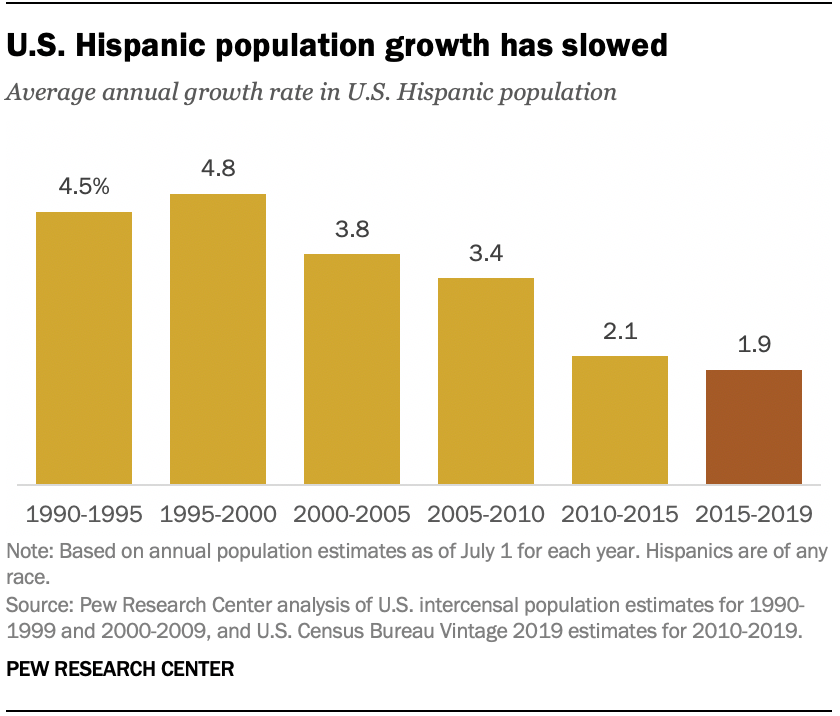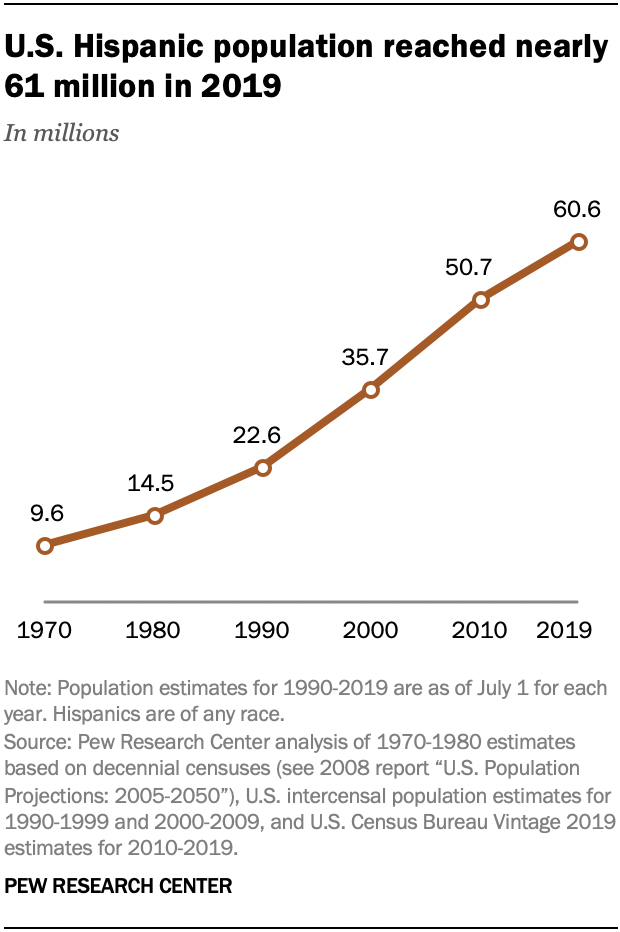Describe the Population Trends in South America Today
At the peak of population growth during the second stage the proportion of children tends to be high while in the third stage it is low. More than half of the national growth from 2010 to 2015 was in the South and a third in the West.

Us Hispanic Population Reached New High In 2019 But Growth Slowed Pew Research Center
Rapid population expansion has had important demographic and social effects.

. The population growth reached a peak in 1953 with an annual growth rate of 273. In 2017 accounted for 136 of the population according to a Pew Research Center analysis of the American Community Survey. Data for all other years are for July 1.
Over the next five decades the majority of US. In 2018 there were 447 million foreign-born individuals or immigrants in the United States. It took hundreds of thousands of years for the world population to grow to 1 billion then in just another 200 years or so it grew sevenfold.
Population live in the South and almost 24 percent in the West. Today 260 million people live in the regions 198 large cities populations of more than 200000 people and generate 60 percent of Latin Americas GDP. The current population of Latin America And The Caribbean in 2022 is 665450783 a 087 increase from 2021.
In the past 50 years mostly from Latin America and Asia. Slums in South America go by different names such as barrios Term used to describe a slum in the northern parts of South America and Middle America. This dramatic growth has been driven largely by increasing numbers of people surviving to reproductive age and has been.
Today a near-record 14 of the countrys population is foreign born compared with just 5 in 1965. The record share was in 1890 when immigrants were 148 of the total. In South America the proportion of the population under 15 years is still relatively high.
Census Bureau 2000 to 2010 Intercensal Population Estimates. Census points out that growth in the south is most likely related to the aging of the baby boom generation as they retire and head for warmer climates. Most people living in the south describe themselves as Christian 76 followed by those who are non-religious 19 and those who follow non-Christian faiths 4.
Latin Americas dramatic shift to a highly urbanized region has significant ramifications many of which have been detailed by the McKinsey Global Institute. In 2011 the global population reached the 7 billion mark and today it stands at about 76 billion. Many of Venezuelas barrios are built on the mountainsides of the Andes.
There are 381 metro areas that are fully or partially contained within the South 371 fully and 10 partially. That is the highest share since 1910 when immigrants were 147 of the total population. Mexicans comprise the bulk of the immigrant population at 25.
The mixing process began when the first Iberians reached South America. This section compares the 50 most populous of those to each other. South America the fourth-largest continent extends from the Gulf of Darién in the northwest to the Tierra del Fuego archipelago in the southAlong with the islands of Tierra del Fuego the continent includes the Galápagos Islands Ecuador Easter Island Chile the Falkland Islands United Kingdom and the Chiloé and Juan Fernández archipelagos Chile.
Population by Metro Area in the South. One of the clearest overall trends is that Americans are moving West and South. The 44 million foreign-born people living in the US.
In fact 7 out of the 10 fastest growing states are in the West. At the same time population in Northern states keeps dropping. North America urban population for 2020 was 303426490 a 066 increase from 2019.
Population of South america. United Nations projections are also included through the year 2100. Data tables maps charts and live population clock.
South America has the 4th highest population growth rate of 083 for 2020 below Africa Oceania and the Asia continent. Update to date information about population of South america in 2022. Chart and table of Latin America And The Caribbean population from 1950 to 2022.
About 60 of the people living in the south are white followed by Hispanics 18 Blacks 13 Asians 6 Indigenous peoples 1 and people who are of two or more races 2. Immigrants Drive Population Growth. Meaning many sections of the population are at a higher risk as health problems are often influenced by societal factors such as education socio-cultural level.
The previous traditions and basic values and attitudes of the Iberianscoupled. Aggregation of urban and rural population may not add up to total population because of different country coverages. Population growth is projected to be linked to new Asian and Hispanic immigration.
The least populous of the compared metro areas has a population of 445227. This still holds today and well into the future. Almost 38 percent of the US.
South Americans population has been shaped by ethnic diverse city physical geography migration and urban growth They are the worlds first largest cotton knit and home to the population of more than 373 million people. The present population of South America is the result of four centuries of mixture among those four componentsAmerican Indians Iberians Africans and more recent overseas immigrantsand their descendants. North America urban population for 2019 was 301433350 a.
Today historical and projected population growth rate immigration median age. In Venezuela or favelas Term used to describe a slum in parts of South America particularly Brazil. Nearly 59 million immigrants have arrived in the US.
More than 62 percent of the population lived in the North in 1900. South America will add 36 million in. This is more than 15 times the contribution.
2000 to 2010 Note. Data for 2000 and 2010 reflect census counts as of April 1. Two examples are especially illuminating.
South America had the highest population growth rate during 1950-1966 and will have the lowest growth after 2073. America is said to be a nation of immigrants. Latin America is characterized by a high level of inequity and inequality with a significant percentage of the population in the base of the pyramid.
They make up 14 of the countrys population.

Peru Demographic Trends Britannica

Population Growth Understanding Global Change

Us Hispanic Population Reached New High In 2019 But Growth Slowed Pew Research Center
Belum ada Komentar untuk "Describe the Population Trends in South America Today"
Posting Komentar